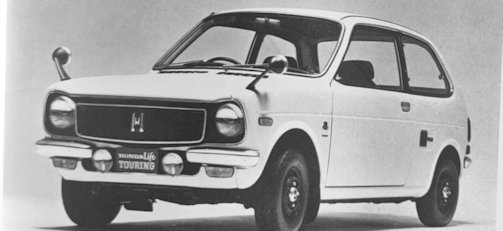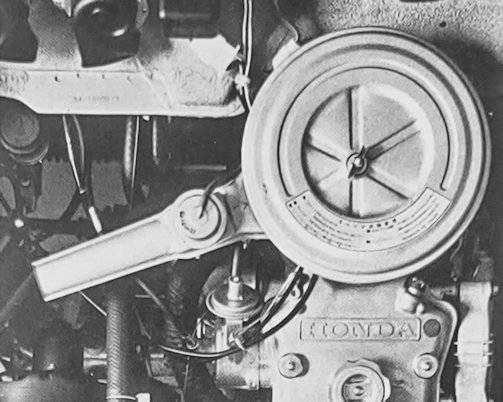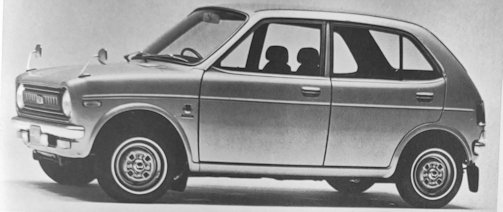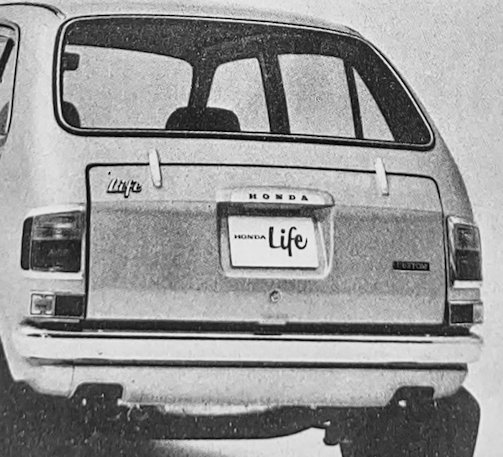Honda Life First Generation
 | |
Production period: | 1971 to 1974 |
Class | Motor Car |
Body versions: | Combined sedan, station wagon, pickup |
Engines: | Gasoline: 0.36 Liter |
Length: | 2995 mm |
Width: | 50.98 in. 1.295 mm |
Height: | 1340-1370 mm |
Wheelbase: | 81.89 in, 2.080 mm |
Curb weight: | 480-540 kg |
Dry weight: | 1,069 1b, 485 kg |
The Honda Life First Generation is a small Japanese car manufacturer Honda from 1971 to 1974.
History
The Honda Life, and generally follows the established two-cylinder transverse engine, driving the front wheels layout of the 'N' series.But there some important departures from normal Honda practice.The Life is the first water cooled Honda since the demise of the S800 sports car. Once staunch believers in air cooling Honda have reverted to water cooling because of its noise suppressing ability. This was current among Japanese 360 cc car manufacturers, and all but one factory offers cars with water cooled engines in this class.
The Life engine is an in-line 354 cc two cylinder ohc unit. The camshaft is driven by a cogged belt (British Uniroyal) and is the first Japanese engine with such a belt. The engine also sports such new Honda innovations as a twin-choke compound downdraught carburetter, forward facing radiator with thermostatically controlled electric fan and a one-piece forged crankshaft with three main bearings (plain). Low and mid-speed torque is the prime design criterion for the engine, and it produces 30 bhp at a 'modest' 8000 rpm. There is also a Town version of the same engine with a lower compression ratio, 21 bhp at 6500 rpm and a milder camshaft. The Life engine incorporates an extremely elaborate dynamic balancing system which consists of twin balancer shafts carrying half moon-shaped balancers which turn counter crankshaftwise to offset the inherent unbalancing force of the in-line two cylinder engine with 3600 crank. The balancer shafts are driven by sprockets and chains.
Transmission is placed in line with the engine, or 'behind' the engine, to compress the power unit forward, so that optimum utilization of the overall length can be made. By law the overall length and width of 360 cc cars are limited to under 3000 mm. and 1300 mm. respectively. By changing to the in-line power unit layout, Honda have succeeded in reserving 82 percent of the total length for passenger and luggage accommodation. In fact the cabin length of the Life matches those of some of our 1-1.2 litre small cars, and Honda are offering four-door versions of the Life as well as the two-door saloon. The gearbox is an all-synchromesh four-speed unit with four indirect ratios. The 21 bhp Town model has a three-speed box. Honda's own automatic, much along the same design as the 'N' automatic, will be offered later. Front suspension is by MacPherson struts, and a rear dead axle on a pair of two leaf semi-elliptic springs is used at the rear. Steering is by rack and pinion, and stopping power is provided by an all drum brake system. The Life is slightly more expensive than the comparable N360.
The first generation was as three- and five-door hatchback, as a three-door station wagon, five-door Van called Step Van, and two-door pickup offered. He was powered by a 27 kW (36 hp) two-cylinder engine with 356 cc displacement with Water not air cooling for new Honda.
Honda added another model to their extensive 360 cc car range. The Honda Life, and generally follows the established two-cylinder transverse engine driving the front wheels layout of the 'N' series. But there some important departures from normal Honda practice.
The Life is the first water cooled Honda since the demise of the S800 sports car. Once staunch believers in air cooling Honda have reverted to water cooling because of its noise suppressing ability. The Life engine is an in-line 354 cc two-cylinder ohc unit. The camshaft is driven by a cogged belt The engine
also sports such new Honda innovations as a twin-choke compound downdraught carburettor, forward facing radiator with thermostatically controlled electric fan and a one-piece forged crankshaft with three main bearings (plain). Low and mid-speed torque is the prime design criterion for the engine, and it produces 30 bhp at a 'modest' 8000 rpm. There is also a Town version of the same engine with a lower compression ratio, 21 bhp at 6500 rpm and a milder camshaft. The Life engine incorporates an extremely elaborate dynamic balancing system which consists of twin balancer shafts carrying half-moon-shaped balancers which turn counter-crankshaft wise to offset the inherent unbalancing force of the in-line two-cylinder engine with 360° crank. The balancer shafts are driven by sprockets and chains.

PERFORMANCE
- Power-weight ratio: 35.6 lb/hp, 16.1 kg/hp
- Max power (DIN): 30 hp at 8,000 rpm
- Max torque (DIN): 21 1b ft, 2.9 kg m at 6,000 rpm
- Max engine rpm: 8,500; 84.3 hp/l
- Max speeds: (1st) 19 mph, 30 km/h; (2nd) 30 mph, 48 km/h: (3rd) 47 mph, 76 km/h; (4th) 71 mph, 115 km/h
Transmission is placed in line with the engine, or 'behind' the engine, much like the Fiat 128 / 127, to compress the power unit forward, so that optimum utilization of the overall length can be made.

By law the overall length and width of 360 cc cars are limited to under 3000 mm. and 1300 mm. respectively. By changing to the in-line power layout, Honda have unit succeeded in reserving 82 per cent of the total length for passenger and luggage accommodation. In fact, the cabin length of the Life matches those of some of our 1-1.2 litre small cars, and Honda offering four-door versions of the Life as well as the two-door saloon.
The gearbox is an all-synchromesh four-speed unit with four indirect ratios. The 21bhp Town model has a three-speed box. Honda's own automatic, much along the same design as the 'N' automatic.
Front suspension is by MacPherson struts, and a rear dead axle on a pair of two leaf semi-elliptic springs is used at the rear. Steering is by rack and pinion, and stopping power is provided by an all-drum brake system.
The Life is slightly more expensive than the comparable N360 also as a van and wagon models up to 1974.
PERFORMANCE: Life Touring SS 2-door Sedan
- compression ratio: 9:1
- max power (DIN): 36 hp at 9,000 rpm
- max torque (DIN): 23 1b ft. 3.2 kg m at 7,000 rpm
- max engine rpm: 10,000; 101.1 hp/l
- 2 Keihin CV horizontal carburettors,
- max speeds: (I) 21 m h, 33 km/h; (II) 33mph. 53 km/h; (III) 51 mph. 82 km/h(IV) 75 mph, 120 km/h
- power-weight ratio: 29.7 lb/hp, 13.7 kg/hp.

Rating
Technical
-
Honda Life 1st gen Technical details and specifications (1971-1974)
ENGINE
location front, transverse
4 stroke; 2 cylinders, in line
Engine capacity: 21.7 cu in, 356 cc
bore and stroke: 2.64 x 1.99 in, 67 x 50.6 mm
compression ratio: 8.8:1
light alloy cylinder block with cast iron liners
light alloy head
3 crankshaft bearings
valves: overhead, rockers
camshafts: 1, overhead
lubrication: eccentric pump, full flow filter
5.3 imp pt, 6.3 US pt, 3 1
1 Keihin downdraught twin barrel carburettor
fuel feed: electric pump
water-cooled
TRANSMISSION
driving wheels: front
clutch: single dry plate (diaphragm)
gearbox: mechanical
gears: 4, fully synchronized
ratios: 1st 4.700, 2nd 2.846, 3rd 1.833, 4th 1.272, rev 4.847
gear lever location: central or auto steering column
gearbox: automatic transmission with 3 ratios: ratios: 1st 3.444, 2nd 1.791, 3rd 1.161. rev 3.719
final drive: helical spur gears
axle ratio: 5.429CHASSIS
type integral with front subframe
front suspension: independent, by McPherson, coil springs/telescopic damper struts, lower wishbones (trailing links), anti-roll bar
rear suspension: rigid axle, semi-elliptic leafsprings, telescopic dampers.STEERING
rack-and-pinion
turns lock to lock: 3.20.
turning circle (between walls): 28.9 ft, 8.8 mBRAKES
drum, single circuit
swept area: front 39.1 sq in, 252 sq cm
swept area: rear 39.1 sq in, 252 sq cm
total 78.2 sq in, 504 sq cm.
ELECTRICAL EQUIPMENT
12 V
26 Ah battery
30 A alternator
Nihon Denso distributorDIMENSIONS AND WEIGHT
wheel base: 81.89 in, 2.080 mm
tracks: 44.49 in, 1,130 mm front, 43.70 in. 1,110 mm rear
length: 117.91 in, 2,995 mm
width: 50.98 in. 1.295 mm
height: 52.76 in, 1,340 mm
ground clearance: 6.50 in. 165 mm
dry weight: 1,069 1b, 485 kg
distribution of weight: 62.9% front, 37.1% rear© Motor car History
-
Honda Life 1st gen Service Guide (1971-1974)
fuel: 85-90 oct petrol
engine sump oil: 5.3 imp pt, 6.3 US pt, 3 1, SAE 10W-30. change every 3,100 miles, 5,000 km
gearbox and final drive oil: 3.5 imp pt, 4.2 US pt. 2 1, SAE 10W-30. change every 25.000 miles, 40,000 km
coolant capacity: 5.3 imp pt, 6.3 US pt
tappet clearances: inlet 0.003 in. 0.08 mm. exhaust 0.003 in, 0.08 mm
valve timing: 0° 30° 40° 0° Life Touring SS valve timing: 10° 30° 40° 0°
tyre pressure: front 21 psi, 1.5 atm, rear 21 psi, 1.5 atm
width of rims: 3.5"
tyres: 5.20 x 10.
fuel tank: 5.7 imp gal. 6.9 US gal. 26 1.© Motor car History




